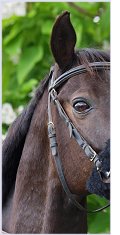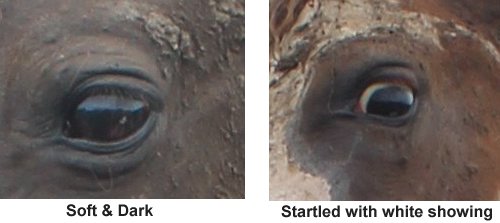 Like most prey animals, horses have eyes set on the sides of their heads giving them almost 350 degree vision that allows them to see a predator at nearly any angle – in effect it is “panoramic” vision. Only about 65 degrees from center is highly focused and binocular. Even though the other 285 degrees is monocular, it serves the purpose. It is very sensitive to motion and catches nearby activity quickly.
Like most prey animals, horses have eyes set on the sides of their heads giving them almost 350 degree vision that allows them to see a predator at nearly any angle – in effect it is “panoramic” vision. Only about 65 degrees from center is highly focused and binocular. Even though the other 285 degrees is monocular, it serves the purpose. It is very sensitive to motion and catches nearby activity quickly.
There are two blind spots. A horse cannot see immediately in front of his nose (for about 3 feet.) That means that a jumping horse may briefly lose sight of the obstacle just before he jumps it. He also cannot see between his hips behind his rump for several feet. That is the reason that approaching a horse from directly behind his tail is dangerous. He does not see you coming. When you reach him, your touch or motion so unexpectedly close can trigger a seemingly unprovoked kick.
A horse will raise or lower its head to increase its range of binocular vision. His face must be looking at the object in a straight-on view. To see an object in the distance, he raises his head. To see an object on the ground, he drops his head and focuses his vision in front and down.

Depending on what work a horse is expected to do, it is important to know his visual capacity. Jumper or a trail horse? Cutting or barrels? Arena or Country Riding? One needs more forward vision to assess coming obstacles. Others need more downward vision to pick the way through rocks and ground traps. Another may just look impressive and regal but have a very foreshortened sight.
As you can see from the diagrams above, jumpers need to be able to comfortably get their heads up to assess an upcoming jump. A cantering dressage horse has very limited forward vision if his back is rounded and his face on the vertical.
Vision sometimes dictates head carriage. Needed head carriage can make a difference what type of bit your horse will use. (see Bits)
Horses are very sensitive to motion – usually first detected in the peripheral vision without much acuity and the first indication of predatory activity. The motion is blurred but visible and can cause a horse to act defensively when they perceive it but cannot focus on it yet. Blinders on horses obviously decrease the peripheral vision along with any distractions observed there.
Horses are not color blind, but they can only perceive the blue and green spectrums: more like humans with red-green color blindness. Certain colors such as red and related colors appear green. It is also especially difficult for horses to distinguish between yellow and greens. Jumpers will jump better if the obstacles are painted a different color from the footing or the surrounding landscape so that they can judge them more accurately. Studies have shown that horses are less likely to have a rail down when the jump is painted with two or more contrasting colors, rather than one single color.
Horses adapted to grazing in open areas and grazing at night. Both activities are done for extended periods of time without the need for quick changes to lighting conditions. Due to structures in their eye that are missing in ours (tapetum lucidum which reflects light back into the eye in low light conditions, and the corpora nigra, effective at shading sunlight coming from above), they have superior night vision, and better vision on cloudy days than in bright sunshine. However, they are much slower to adjust to quick lighting changes such as coming into or leaving a dark barn on a sunny day. The inability to quickly adjust to light conditions can affect activities such as trailer loading. A dark trailer is more scary than a bright one. A sunny-day load is harder to see than a cloudy day load where the contrast is lower. Obstacles set in shady areas as a horse comes out of bright sun may actually be unseen until the horse is right on them and startled by their sudden appearance.
For a trail horse that will be ridden in varied terrain including bright sun and darker shaded forests, it is important to understand his delayed light adjustment time. As he enters or leaves the forested terrain, he feels less secure. And movement or sound coming from a darkened area or overly bright area can startle him.
Most horses are slightly near sighted with the exception of wild horses which appear to be slightly far sighted.
 They eye of a horse can tell you a lot about his attitude at the moment. A horse’s eye should always appear soft and dark (with the exception of some blue-eyed horses or some appaloosas who have white showing at all times). If the eye is opened wide and you see the white of the eye surrounding the dark circle, it usually means that the horse is frightened.
They eye of a horse can tell you a lot about his attitude at the moment. A horse’s eye should always appear soft and dark (with the exception of some blue-eyed horses or some appaloosas who have white showing at all times). If the eye is opened wide and you see the white of the eye surrounding the dark circle, it usually means that the horse is frightened.
See is a particularly interesting article.
We certainly don’ t know everything. Please share your expertise. Comment on what is already written or Suggest a Category and Educate us about it. Grow Horse-Pros.com©
